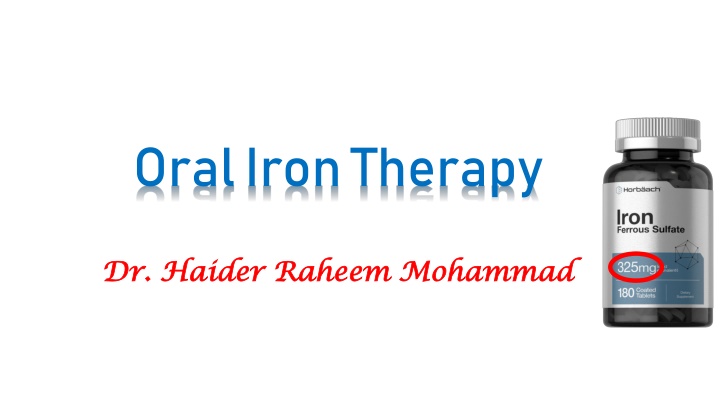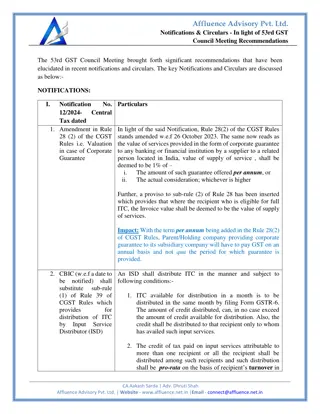
Iron Deficiency Anemia and Oral Iron Therapy Overview
Learn about iron deficiency anemia, its impact on the body, iron absorption, distribution, and the role of oral iron therapy in treating it. Understand the importance of iron balance, dietary requirements, and the absorption process to maintain optimal health.
Download Presentation

Please find below an Image/Link to download the presentation.
The content on the website is provided AS IS for your information and personal use only. It may not be sold, licensed, or shared on other websites without obtaining consent from the author. If you encounter any issues during the download, it is possible that the publisher has removed the file from their server.
You are allowed to download the files provided on this website for personal or commercial use, subject to the condition that they are used lawfully. All files are the property of their respective owners.
The content on the website is provided AS IS for your information and personal use only. It may not be sold, licensed, or shared on other websites without obtaining consent from the author.
E N D
Presentation Transcript
Oral Iron Therapy Dr. Haider Raheem Mohammad Dr. Haider Raheem Mohammad
Iron Deficiency Anemia Iron deficiency is a state of negative iron balance in which the daily iron intake and stores are unable to meet the RBC and other body tissue needs. The body contains approximately 3.5 g of iron, of which 2.5 g are found in Hgb. A significant amount of iron is stored as ferritin or aggregated ferritin (hemosiderin) in the reticuloendothelial cells of the liver, spleen, and bone marrow and by hepatocytes. Ferritin circulates at concentrations that reflect total iron body stores. Only a small fraction of iron is found in plasma (100 to 150 mcg/dL), and most is bound to transferrin, the transport protein.
The regulation of iron absorption, uptake distribution in the body. The transport of iron is regulated in a similar fashion to enterocytes other transporting such macrophages. and in iron- cells as
Table 3-1: Body iron distribution. Iron Content, mg Adult Male, 80 kg Adult Female, 60 kg Hemoglobin 2500 1700 Myoglobin/enzymes 500 300 Transferrin iron 3 3 Iron stores 600-1000 0-300
Model of the Hemoglobin Tetramer With the -Chain Subunits Facing the Reader. Eachsubunitcontainsamoleculeofhemeattachedtoanatomofiron.
Iron Deficiency Anemia Despite the continuing turnover of RBC, iron stores are well preserved because the iron is recovered and reused in new erythrocytes. Only about 0.5 to 1 mg/day of iron is lost from urine, sweat, and the sloughing of intestinal mucosal cells that contain ferritin in men and in nonmenstruating women. Menstruating women lose approximately an additional 1 mg of iron per day. Pregnancy and lactation are other common sources of iron loss.
Iron Deficiency Anemia Individuals with normal iron stores absorb roughly 10% of ingested dietary iron. The average American diet contains 6 mg of elemental iron/1,000 kcal. Thus, an average daily intake of 10 to 12 mg is enough to replace the 1 mg lost daily. For menstruating, pregnant, or lactating women, however, the daily iron intake requirement may be as high as 20 to 30 mg.
Iron Deficiency Anemia Iron is absorbed from the duodenum and upper jejunum by an active transport mechanism. Dietary iron exists primarily in the ferric state and is converted to the more readily absorbed ferrous form in the acid environment of the stomach. The ferrous form binds to transferrin for transport to the bone marrow, where it is incorporated into the Hgb of mature erythrocytes. GI absorption of iron is increased from the usual 10% to as much as threefold to fivefold in iron-deficiency states or when erythropoiesis occurs at a more rapid rate. Animal sources of iron, heme iron, are better absorbed than plant sources, nonheme iron.
Table 3-2: Good sources of iron. Serving Size Food Amount (mg) Total cereal 1 cup 18 Grape-Nuts cereal 1 cup 18 Instant Cream of Wheat 1 cup 8.2 Instant plain oatmeal 1 cup 6.7 Wheat germ 1 oz. 2.6 Broccoli 1 medium stalk 2.1 Baked potato 1 medium 2.7 Raw tofu 1/2 cup 4 Lentils 1/2 cup 3.3 Beef chuck 3 ounces 3.2
Iron Deficiency Anemia A number of issues including disease, surgical bypass, a hypochloric state, infections, or drug food complexes can alter the absorption of iron. Anemia caused by iron deficiency is the most common nutritional deficiency worldwide. Although iron deficiency anemia has many causes, blood loss is considered one of the more common. Each milliliter of whole blood contains 0.5 mg of iron, whereas each milliliter of packed RBC (PRBC) contains 1 mg of iron. Common causes of chronic blood loss include peptic ulcer disease, hemorrhoids, ingestion of GI pregnancies, and multiple blood donations. irritants, menstruation, multiple
Oral Iron Dosing H.P., a 31-year-old woman, is seen in the clinic. Her chief complaints include weakness, dizziness, and epigastric pain. She has a 5-year history of peptic ulcer disease, a 10-year history of heavy menstrual bleeding, and a 15-year history of chronic headaches. She has two children who are 1 and 3 years of age. H.P. is currently taking minocycline 100 mg twice daily (BID) for acne, ibuprofen 400 mg as needed for headaches, and esomeprazole 40 mg daily. A review of her systems is positive for decreased examination reveals a pale, lethargic, white woman appearing older than her stated age. Her vital signs are within normal limits; her heart rate is regular at 100 beats/minute. Her examination is notable for pale nail beds and splenomegaly. exercise tolerance. Physical
Oral Iron Dosing Significant laboratory results include the following: Hgb, 8 g/dL Platelet count, 500,000/ L MCV, 75 fL MCHC, 300 g/L Serum ferritin, 9 ng/mL Total iron-binding capacity (TIBC), 450 g/dL Iron deficiency is determined to be the cause of H.P. s anemia. An upper GI series with a small bowel follow-through are planned to evaluate her persistent epigastric pain. How should H.P. s iron deficiency be managed? What dose of iron should be given to treat H.P. s iron deficiency anemia and for how long? Hct, 26% Reticulocyte count, 0.2% MCH, 23 pg/cell Serum iron, 40 g/dL 4+ stool guaiac (normal, negative)
Oral Iron Dosing The primary treatment for H.P. should be directed toward control of the underlying causes of anemia, which in this case are many. H.P. s iron stores are low because of GI blood loss, multiple childbirths, heavy menstrual flow, decreased dietary iron absorption, and perhaps, an inadequate diet. Therefore, the cause of her GI blood loss should be corrected, her dietary intake should be analyzed and modified, and supplemental iron should be prescribed to replenish her stores and correct the anemia.
Oral Iron Dosing The usual adult dose of ferrous sulfate is 325 mg (one tablet) administered two to three times daily, between meals. However, because of limited absorption of iron in the intestines, repletion with lower doses of iron has been shown to be effective, potentially minimizing side effects and improving compliance. If no iron is being lost through bleeding, the required daily dose of elemental iron can be calculated using a formula that assumes that 0.25 g/dL/day is the maximal rate of Hgb regeneration.
Oral Iron Dosing Elemental iron (mg/day) = 0.25g Hgb/100 mL blood/day (5,000 mL blood) (3.4 mg Fe/1 g Hgb) = 40 mg Fe/day/20% absorption (approximate absorption rate in iron- deficient states) = 200 mg Fe/day = 1,000 mg ferrous sulfate/day (ferrous sulfate contains 20% elemental iron) = 325 mg three times daily (TID) ferrous sulfate
Product Selection What are the differences between iron products? Which is the product of choice? The ferrous form of iron is absorbed three times more readily than the ferric form. Although ferrous sulfate, ferrous gluconate, and ferrous fumarate are absorbed almost equally, each contains a different amount of elemental iron that is available for absorption. Carbonyl iron, another iron product, is available, but its use may be limited owing to the fact that iron in this form must be solubilized by gastric acid to be absorbed. Table 3-3 compares the iron content of several oral iron preparations to assist in making appropriate treatment choices for patients.
Table 3-3: Comparisons of iron preparations. Preparation Dose (mg) Fe2+Content (mg) Fe (%) Ferrous sulfate 325 65 20 Ferrous fumarate 324 106 33 Ferrous gluconate 300 34 11 Carbonyl iron 45 Slow Fe (time-released) 160 50 31






















